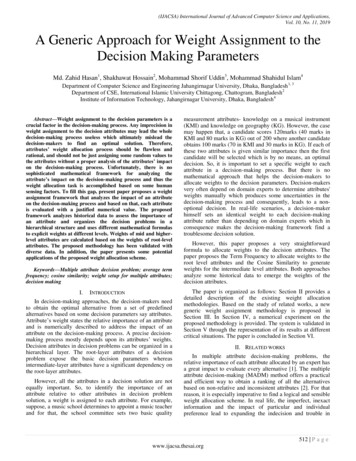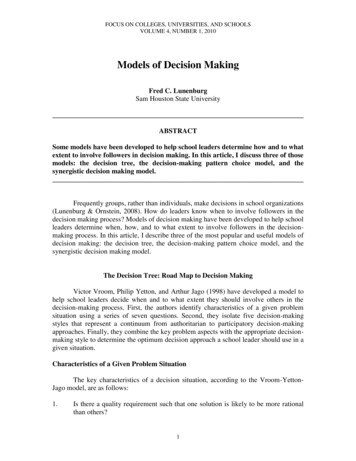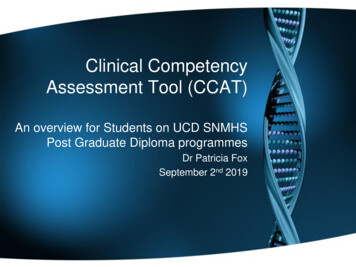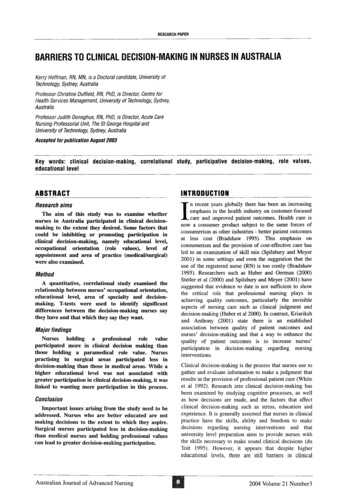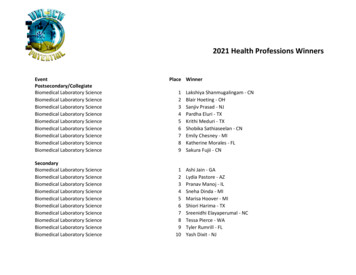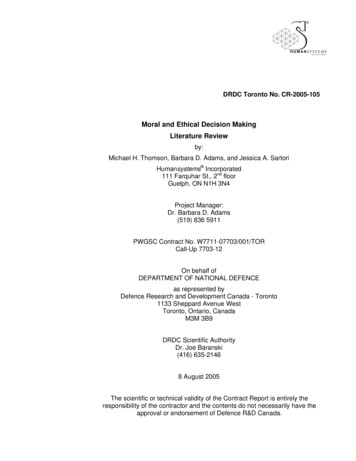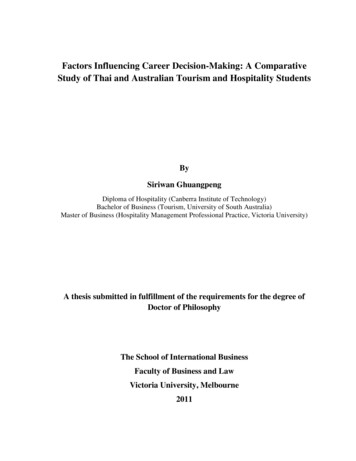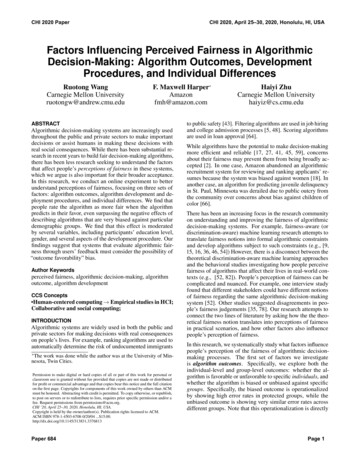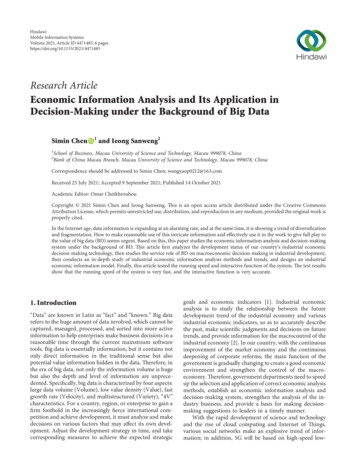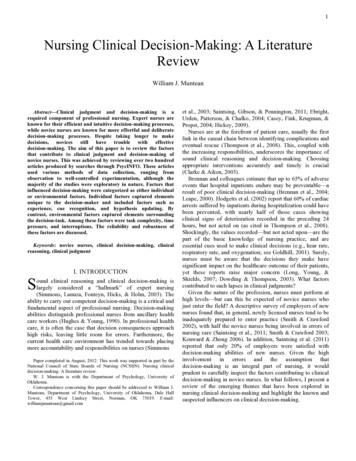
Transcription
1Nursing Clinical Decision-Making: A LiteratureReviewWilliam J. MunteanAbstract—Clinical judgment and decision-making is arequired component of professional nursing. Expert nurses areknown for their efficient and intuitive decision-making processes,while novice nurses are known for more effortful and deliberatedecision-making processes. Despite taking longer to makedecisions, novices still have trouble with effectivedecision-making. The aim of this paper is to review the factorsthat contribute to clinical judgment and decision-making ofnovice nurses. This was achieved by reviewing over two hundredarticles produced by searches through PsycINFO. These articlesused various methods of data collection, ranging fromobservation to well-controlled experimentation, although themajority of the studies were exploratory in nature. Factors thatinfluenced decision-making were categorized as either individualor environmental factors. Individual factors captured elementsunique to the decision-maker and included factors such asexperience, cue recognition, and hypothesis updating. Bycontrast, environmental factors captured elements surroundingthe decision-task. Among these factors were task complexity, timepressure, and interruptions. The reliability and robustness ofthese factors are discussed.Keywords: novice nurses, clinical decision-making, clinicalreasoning, clinical judgmentSI. INTRODUCTIONound clinical reasoning and clinical decision-making islargely considered a “hallmark” of expert nursing(Simmons, Lanuza, Fonteyn, Hicks, & Holm, 2003). Theability to carry out competent decision-making is a critical andfundamental aspect of professional nursing. Decision-makingabilities distinguish professional nurses from ancillary healthcare workers (Hughes & Young, 1990). In professional healthcare, it is often the case that decision consequences approachhigh risks, leaving little room for errors. Furthermore, thecurrent health care environment has trended towards placingmore accountability and responsibilities on nurses (SimmonsPaper completed in August, 2012. This work was supported in part by theNational Council of State Boards of Nursing (NCSBN). Nursing clinicaldecision-making: A literature review.W. J. Muntean is with the Department of Psychology, University ofOklahoma.Correspondence concerning this paper should be addressed to William J.Muntean, Department of Psychology, University of Oklahoma, Dale HallTower, 455 West Lindsey Street, Norman, OK 73019. E-mail:williamjmuntean@gmail.comet al., 2003; Saintsing, Gibson, & Pennington, 2011; Ebright,Urden, Patterson, & Chalko, 2004; Casey, Fink, Krugman, &Propst, 2004; Hickey, 2009).Nurses are at the forefront of patient care, usually the firstlink in the causal chain between identifying complications andeventual rescue (Thompson et al., 2008). This, coupled withthe increasing responsibilities, underscores the importance ofsound clinical reasoning and decision-making. Choosingappropriate interventions accurately and timely is crucial(Clarke & Aiken, 2003).Brennan and colleagues estimate that up to 65% of adverseevents that hospital inpatients endure may be preventable—aresult of poor clinical decision-making (Brennan et al., 2004;Leape, 2000). Hodgetts et al. (2002) report that 60% of cardiacarrests suffered by inpatients during hospitalization could havebeen prevented, with nearly half of those cases showingclinical signs of deterioration recorded in the preceding 24hours, but not acted on (as cited in Thompson et al., 2008).Shockingly, the values recorded—but not acted upon—are thepart of the basic knowledge of nursing practice, and areessential cues used to make clinical decisions (e.g., hear rate,respiratory rate, and oxygenation; see Goldhill, 2001). Surely,nurses must be aware that the decisions they make havesignificant impact on the healthcare outcome of their patients,yet these reports raise major concern (Long, Young, &Shields, 2007; Dowding & Thompson, 2003). What factorscontributed to such lapses in clinical judgments?Given the nature of the profession, nurses must perform athigh levels—but can this be expected of novice nurses whojust enter the field? A descriptive survey of employers of newnurses found that, in general, newly licensed nurses tend to beinadequately prepared to enter practice (Smith & Crawford2002), with half the novice nurses being involved in errors ofnursing care (Saintsing et al., 2011; Smith & Crawford 2003;Kenward & Zhong 2006). In addition, Saintsing et al. (2011)reported that only 20% of employers were satisfied withdecision-making abilities of new nurses. Given the highinvolvement in errors and the assumption thatdecision-making is an integral part of nursing, it wouldprudent to carefully inspect the factors contributing to clinicaldecision-making in novice nurses. In what follows, I present areview of the emerging themes that have been explored innursing clinical decision-making and highlight the known andsuspected influencers on clinical decision-making.
W. J. Muntean Clinical decision-makingII. LITERATURE REVIEW PROCESSAn evaluation of the peer-reviewed literature generated fromPsycINFO with various combinations of the terms“decision-making”, “judgment”, “clinical”, “novice”, and“nursing” was carried out. The following limits were placedon the search: (1) articles must come from peer-reviewedjournals; (2) only English language publications werereviewed; and (3) full text of the article must be available.Using these criteria, the search produced an overwhelming setof articles—over 1500 studies. Of these articles, roughly 800were loosely related to nursing clinical decision-making andwere reviewed. This subset of articles produced about 200articles that had strong relevance to clinical decision-makingand were subjected to a more detailed and thorough review.The following paper summarizes research from the finalsubset of articles. In addition to a database search, citations toand from articles were also used. This led to the review ofseveral book chapters, but to foreshadow a general themefound in the literature, most chapters are not reported becauseof the highly subjective nature of the content. Overall, thisprocess uncovered three research themes on clinicaldecision-making—research on factors that influence nurseparticipation in clinical decision-making, research comparingdecision-making processes between novice and expert nurses,and research on factors known (or suspected) to influencedecision-making in nursing.The single primary objective of this literature review was touncover factors that influence clinical decision-making (eitherpositively or negatively) in first-year novice nurses. However,there is a dearth of studies conducted with such a specificresearch goal; studies either deviate on participants used orfocus on other aspects of clinical decision-making. There areseveral likely reasons that research on clinicaldecision-making of novice nurses is limited. First, there is alack of consistency as to what constitutes a novice nurse(Simmons et al., 2003). Several researchers qualify nursingstudents (perhaps inappropriately) as novices (Tanner,Padrick, Westfall, & Putzier, 1987; Thiele, Holloway,Murphy, & Pendarvis, 1991; Baxter & Rideout, 2006;Lofmark, Smide, & Wikblad, 2006; Shin, 1998), whereasothers define it within a single year (Ebright et al., 2004;Wainwright, Shepard, Harman, & Stephens, 2011; Saintsing etal., 2011; Greenwood & King, 1995; Forneris &Peden-McAlpine, 2007) and still others define it as within twoyears (Hoffman, Aitken, & Duffield, 2009; Grobe, Drew, &Fonteyn, 1991).Second, a substantial number of clinical decision-makingresearchers have seemingly focused on the development ofdecision-making abilities and therefore include novice nursesas a mere baseline comparison group (Chunta & Katrancha,2010; Benner, Tanner, & Chesla, 1992). Lastly, researchersfocusing on the core decision-making process are moreinterested in nurses whose decision-making abilities arepurportedly fully developed (e.g., expert nurses), which makesthe implicit assumption that all novice decision-making isinferior and unstable (Buckingham & Adams, 2000a, 2000b).Often times these studies are carried out on specialized nurses,requiring more expertise and experience than most novice2nurses have (Kaasalainen et al., 2007; Marshall, West, &Aitken, 2011; Monterosso et al., 2005). Despite the dispersivefocus of the field, studies that had strong implications fornovice decision-making were included and describedaccordingly.The three lines of research that emerged from the review areintimately related and need to be considered collectively. Forinstance, factors that influence the frequency of participationin decision-making may have differential effects on expert andnovice nurses (Hoffman, Donoghue, & Duffield, 2004;Prescott, Dennis, & Jacox, 1987). Frequency ofdecision-making participation is assumed to play a criticaldevelopmental role in clinical competency (see, e.g., Thiele etal., 1991). Those who receive more opportunity in clinicaldecision-making are provided with more feedback on theirdecisions and interventions, ultimately leading to betterquality decisions in the future (Thiele, Baldwin, Hyde, Sloan,& Strandquist, 1986). This is not to say that experience aloneaccounts for the development of decision-making skills(Benner, 1984), but instead it allows for more occurrences offactors that contribute to clinical decision-making skilldevelopment (Zinsmeister & Schafer, 2009).Studies comparing novice and expert nurses are importantfor understanding clinical decision-making. This line ofresearch focuses on the underlying decision-making processinvolved when nurses make clinical decisions. Varioustheoretical frameworks are put forth in the literature and eachis useful for investigating decision-making factors because theframeworks break down the decision process intosubcomponents—providing simpler methods of investigatinginfluencers. For instance, expert nurses have been shown touse more forward reasoning in decision-making (e.g., dataevaluation triggers a hypothesis), while novice nurses areshown to use more backward reasoning (e.g., hypothesisconstrains data evaluation). Therefore, any manipulationaffecting the collection of information (e.g., the quality ofinformation, the ratio of confirming/disconfirming evidence toa particular action plan, etc.) will differentially impact expertand novice nurses in their ability to update their hypothesis.Hence, offering a method to differentiate between novice andexpert nurses (Lamond, Crow, & Chase, 1996; Lauri &Salantera, 1995).The final theme in the literature review is research thatinvestigated factors contributing to clinical decision-making.These studies tend to be qualitative in nature (e.g., focusgroups, think-aloud, observations) and use self-reportquestionnaires or survey methods for data collection (Funk,Tornquist, & Champagne, 1995), which might be problematicbecause conclusions are drawn on an ad hoc, exploratory basis(for a lengthier explanation, see Thompson, 1999a). That is,researchers explore transcriptions of interview or observationdata and find general decision-making factors that are reportedby participants. No further confirmatory research is conductedto determine whether the factors in question are discoveredthrough chance or are actually found in the nursingpopulation.Few studies employ experimental techniques (e.g.,manipulation of variables, proper controls, randomization,etc.). This speaks to the difficulty and complexity ofconducting nursing research in applied environments
W. J. Muntean Clinical decision-making(Dowding & Thompson, 2003; Aitken, Marshall, Elliott, &Mckinley 2011). Although experimentation has the benefit ofcontrolling for nuisance variables (e.g., confounds) andshowing causality, it runs the risk of oversimplification. Andwhile reducing nursing environments to vignettes for the sakeof experimentation might show the basic processes ofdecision-making, doing so can lose sight of the overall pictureof applicability. It is the classic argument of in vitro versus invivo—applied versus laboratory research. Therefore,regardless of the exploratory nature of nursing clinicaldecision-making research, these studies lay the groundworkfor future experiments to confirm the critical factors thatimpact clinical judgment and decision-making.Collectively, these three themes highlight two categories ofvariables that impact nursing clinical decision-making,individual factors (e.g., cue recognition, knowledge structure,ability to update working hypothesis, communication, currentstate of emotion, etc.) and environmental factors (e.g., taskcomplexity, time pressure, interruptions, professionalautonomy, etc.). Individual factors focus on thedecision-maker and various properties of informationprocessing. By contrast, environmental factors relate to theto-be-processed information. For example, a nurse’s cuerecognition ability will directly impact the efficiency andaccuracy of their decisions—an individual factor. However,task complexity— an environmental factor—affects thepresentation of cues and has an indirect impact on thedecision-maker. The agreement on these factors in theliterature is mixed. Some factors, such as task complexity,have repeatedly been shown to impact clinicaldecision-making (Corcoran, 1986a; Hicks, Merritt, & Elstein,2003; Hughes & Young, 1990; Lewis, 1997). However, therehas been less agreement on other factors, such as educationlevel or experience (Sanford, Genrich, & Nowotny, 1992; delBueno, 1983; Shin, 1998; Bechtel, Smith, Printz, Gronseth,1993). Where appropriate, reasons for disparate results arediscussed.III. APPLIED DECISION-MAKING RESEARCH:METHODOLOGICAL DIFFICULTIESAs mentioned above, the majority of studies reviewedimplement qualitative methods, varying primarily betweeneither observational designs or think aloud protocols, althoughthere are a substantial amount of studies that collect datathrough surveys. There are several issues with these methodsthat are worth mentioning. First, for qualitative research,regardless of the means of collection, data must be codedeither descriptively or thematically. This requires multipletrained coders to ensure reliability in coding. Furthermore,statistics should be provided as to the amount of agreementbetween coders, also known as inter-rater reliability. Giventhat the majority of nursing research is qualitative (Cullum,1997; Thompson, McCaughan, Cullum, Sheldon, & Raynor,2004; Thompson, 1999a), reliable coding is imperative soresults and conclusions are not contingent on researcher bias3or ambiguous constructs. However, nearly all articlesreviewed either failed to include multiple raters or includedmultiple raters but provided no measure of inter-raterreliability. This issue is so prevalent in the nursing clinicaldecision-making literature that Thompson and colleaguespublished a paper calling on researchers to be moretransparent in coding procedures (Thompson et al., 2004).Employing questionnaires as a means of collecting dataaffords the luxury of obtaining a large sample, but informationcollected through this method is contingent on the decisionmaker’s retrospective memory capabilities. These memoriesare particularly susceptible to a slew of memory biases (e.g.,misattribution, suggestibility, hindsight bias, fluency effects,etc.). Caution should be given when interpreting results fromstudies that use questionnaires to investigate clinicaldecision-making (Aitken et al., 2011). To add to the problem,questionnaire response rates in some studies drop as low as29%, raising the issue of selective sampling bias (Thompson,1999a).An additional method used to investigate nursing clinicaldecision-making is through constructed interviews or focusgroups. These studies use an introspective approach to collectdata: An interviewer guides nurses to explain thedecision-making process and factors that affect it. The mainconcern with all introspective approaches is that it capitalizeson idiosyncrasies of the participant and the environment thatsurrounds them. Generalizability is very limited, unless theproper sampling techniques are used. For instance, factors thatimpact novice nurses in one hospital setting might be uniqueand not prevalent in other hospitals—a conclusion made byBucknall and Thomas (1995). In complex areas of study, suchas nursing, it is extremely challenging and very costly toimplement appropriate sampling techniques and still controlfor nuisance variables.1Setting aside the issue of sampling and generalizability,introspective methodology is not necessarily an improper toolfor investigating nursing clinical decision-making factors. Infact, can be an exceptionally powerful technique for graspinga broad range of influential variables—it casts a wide net onseemingly important factors. However, with any broadresearch approach, additional studies (and to the extentpossible, experimentation) should be carried out to providecorroborating evidence and rule out any idiosyncrasies.Decision classification presents another difficulty in appliedclinical decision-making. What constitutes as a correctdecision? This issue is exacerbated by the fact that mostapplied nursing research lack the feedback to ascertainwhether a nurse’s action plan reached an appropriate outcome.For instance, most observational studies examine nurses forseveral hours over a sequence of several days and observersreceive no feedback on the outcome of their nurse’s decisions(Buckingham & Adams, 2000a; Long et al., 2007; Dowding &Thompson, 2003). Furthermore, not all decisions or action1Stratified random sampling is not the be-all and end-all technique innursing research. Many authors argue that it is more important to get subjectsand data likely to generate robust, rich, and deep understanding (Thompson,1999a).
W. J. Muntean Clinical decision-makingplans can be classified as binary. Decisions are oftenconsidered on gradient scales. Take for example two decisionsor action plans that reach the same conclusion. Despite nodifferences in outcome, the two decisions could differ inefficiency, resources needed, complexity required, andtherefore ultimately differ in quality. One solution offered byBucknall (2000) and King and Clark (2002) is to encourageresearchers to conduct larger scale longitudinal studies. This isan admirable request, indeed, but also a rather costly anddifficult paradigm to implement, hence only several studiesuse this technique (Casey et al., 2004; Standing, 2007; O'Neill& Dluhy, 1997).Lastly, when comparing observational methods to thinkaloud protocols, systematic differences have been observed.Think aloud protocols have been shown to collect a greaterfrequency of decisions than that of observation (Aiken et al.,2011). Specifically, when investigating decision-makinginvolving assessment, diagnosis, and evaluation, think aloudprotocols should be used because it affords information thatcannot otherwise be collected by observation. However, thereare limitations with think aloud protocols. Nurses must becomfortable with a continuous verbalization and they must begiven adequate practice sessions. In addition, the very natureof thinking aloud might itself change the decision process thatoccurs with covert thinking (e.g., Heisenberg effect and/orHawthorne effect; see Thompson, 2011). Observationalmethods also have some limitations. They require the observerto become a participant in the environment and theirinteractions can influence the patient-nurse dynamics—theconsequence is creating an artificial setting (Luker & Kenrick,1992). Therefore, the literature reviewed includes a mix ofboth observational methods and think aloud protocols.Before detailing each category of factors, I briefly describeseveral frameworks of nursing decision-making that have beenendorsed throughout the literature. Although these frameworkshave been put forth primarily to distinguish between noviceand expert nurses, they are insightful and explain the coreelements involved in decision-making. Additionally, theseframeworks provide the context in which the contributingfactors are described in nursing research and, to some degree,in the current review.IV. CLINICAL DECISION-MAKING MODELS ANDFRAMEWORKSOne source of complexity that surrounds nursing clinicaldecision-making is that different nurses use different decisionstrategies. Depending on the dynamics of the task a singlenurse can even use multiple strategies (Corcoran, 1986a,1986b; Jenks, 1993; Cader, Campbell, & Watson, 2005).Factors that influence one method of decision-making may nothave the same effect on another decision strategy (Baker,1997). A unifying approach to nursing clinicaldecision-making is exceptionally difficult for this reason.There are a few proponents of this approach, though.4Buckingham & Adams (2000a, 2000b) suggest that the majorclinical decision-making theories are so similar that they onlydiffer in terminology and semantics. They argue thatdecision-making research would be much more efficient andcommunicable if the research community endorsed thisapproach rather than placing so much energy on distinguishingtheories apart2. Despite the similarities (or differences) threepopular theories are summarized below.Skills acquisition and the humanistic-intuitive approachPerhaps the most influential framework of nursingdecision-making is Benner’s (1984) modification of the skillsacquisition theory (for a review, see Dreyfus & Dreyfus,1986). Benner postulated that clinical decision-makingexpertise is developed through experience as one progressesthrough five stages of skill acquisition. The first stage is thenovice stage, which describes a beginner in the nursingdomain. They learn through instruction and learndomain-specific facts, features, and actions (Gobet & Chassy,2008). Novice decision-making is context free, meaning thatnovices ignore idiosyncrasies of the situation. This results indecision-making that is primarily rule based. It is inflexibleand resulting in very limited performance.After acquiring a fair amount of experience, a noviceprogress to an advance beginner. Advance beginners accountfor more situational variables when making decisions.Decision-making attributes start to become context dependent.They also make use of limited past experience (given that theyhave had a similar past encounter). The competence stageinvolves organization structures such as hierarchicallong-range plans. Decisions are reached with greaterefficiency, albeit still relying on conscious, abstract,analytical, and deliberate planning.The proficiency stage marks holistic thinking rather thanfragmented subcomponents. Problem features are viewed assalient or irrelevant, allowing decision-makers to organize andanalyze a situation intuitively, but analytical thinking is stillrequired to choose the action plan. Lastly, expertise stagerepresents those who can understand a situation intuitively andmake decisions intuitively as well. Accordingly, experts actnaturally and often reach conclusions without explicitunderstanding. Experts can revert to previous stages ofanalytical thinking if a situation is novel or their initialintuition is incorrect.A strength of the humanistic-intuitive model ofdecision-making is its simplicity. It describes the progressionfrom novice to expert succinctly—from a slow and hesitantdecision-maker to a fast and fluid problem solver. It capturesthe relationship between knowledge and experience. Anotherstrength of the theory is that it captures the involvement ofemotion, namely in the intuition process (Benner et al., 1992;Jenks, 1993). Perhaps this is the reason why the frameworkhas been adopted as the standard in nursing clinicaldecision-making (Agan, 1987; Benner & Tanner, 1987;2For an example of the lively ongoing debate on nursing clinicaldecision-making theories, see English, 1993; Darbyshire, 1994; Benner &Tanner, 1987; Cash, 1995; Benner, 1996.
5W. J. Muntean Clinical decision-makingCorcoran, 1986a, 1986b; Crandall & Getchell-Reiter, 1993;Pyles & Stern, 1983; Rew, 1988, 1990, 1991; Schraeder &Fisher, 1986, 1987; Young, 1987). Intuition isphenomenological in spirit and is often described as a feelingof knowing something without conscious use of reason(Banning, 2007) or an understanding without rationale(Benner & Tanner, 1987). For this reason, hypothesis testingis not necessarily used as a criterion for accurate or inaccuratepropositions and reasoning, which raised much skepticism asto whether this approach is scientifically based (Banning,2007; Cash, 1995; English, 1993).Due to the phenomenological nature, researchers using thisapproach have a difficult time unifying the definition ofintuition (Buckingham & Adams, 2000b). As a consequence,nursing decision-making literature is filled with this looseconstruct. For example, over 25% of the articles reviewedused the term ‘gut feeling’ as a proxy for intuition whensurveying nurses on factors that led to their decisions (see,e.g., Burman, Stepans, Jansa, & Steiner, 2002; Pretz & Folse,2011; Ericsson, Whyte, & Ward, 2007). This raises thequestion, how can this body of research differential between‘gut feelings’ and guesses? If surveys included a guess option,how would the endorsement of this choice beinterpreted—especially when a guess resulted in the correctdecision? Would that constitute as intuition, being a gutfeeling guess? Hence, therein lies the biggest criticism of thisframework, construct specificity (Rew, 2000).Recent studies have made attempts to better define intuitionas it is used in nursing clinical decision-making (e.g., domainspecific intuition; Rew, 2000; Smith et al., 2004; Smith, 2006,2007; Miller, 1995; Pretz & Folse, 2011). Rew (2000)conducted a three-phase study on validating an intuitionassessment scale, hoping that it would provide a way tomeasure a nurse’s propensity of utilizing intuition. The scalestarted out with a 50-item questionnaire that covered sixconceptual categories relating to complex decision-making:uses sudden/immediate insight, creativity, risk taking, rigidity,cautiousness, and realistic approach (Rew, 1986; Masters &Masters, 1989). An expert nursing panel reviewed theassessment and reduced the number of questions to 28 items.Following the review, a Content Validity Index was carriedout and revealed a high level of agreement (CVI .96).TABLE IACKNOWLEDGES USING INTUITION IN NURSING SCALEQUESTION#1SCALE ITEMThere are times when I suddenly know what to do for apatient, but I don’t know why.2I am inclined to make decisions based on a sudden flash ofinsight.3There are times when I immediately understand what to dofor a patient, but I can’t explain it to other people.4There are times when I feel that I know what will happen toa patient, but I don’t know why.5There are times when a decision about my patient’s care justcomes to me.6There are some things I suddenly know to be true aboutsome of my patients, but I am unable to support this withconcrete data.7Sometimes I act on a sudden knowledge about a patient toprevent a crisis from developing even when I can’t explainit.Note—Reproduced from Rew (2000)TABLE 2INTUITION FACTORSFACTORSCALE ITEMPhysicalsensationsI get a shiver down my spine when I think something iswrong with my patient.The hair on my arms and neck stand up when somethingis wrong with my patient.I get a lump in my throat when something is wrong withmy patient.I feel cold when something is wrong with my patient.I feel nauseous when something is wrong.PremonitionsI experience a gut reaction when something is wrongwith my patient.I get a bad feeling about a patient’s condition.I get a persistent feeling about a patient’s condition.I get a sinking feeling in my stomach when something isabout to go wrong.SpiritualI connect with my patients at the soul level.connectionsI sense a spiritual connection with my patients.I experience a deep connection with my patients.I do not need verbal communication to sense a spiritualconnection with my patient.Reading cuesI read the non-verbal body language of my patient.I read non-verbal cues of my patient.I can read my patient’s expressions.SensingI sense positive energy coming from my patient.energyI sense negative energy coming from my patient.I sense an energy field around my patientApprehensionI experience a feeling of dread when caring for mypatient.I get a nagging feeling about a patient’s condition.I feel anxious when I think something will go wrong.I get an odd feeling about a patient’s condition.ReassuringI get a calm feeling when I know things will be okay.feelingsI get a peaceful feeling when I know my patient isstable.Note—Reproduced from Smith, Thurkettle, & dela Cruz (2004)In the next phase, the assessment was sent out to 106 nursesand responses were subjected to a principal component factoranalysis. This analysis led to a six-factor model. However,seven questions had very low factor loadings and thus thescale was reduced to 21-items. For the final phase of the study,the reduced scale was administered to an additional set ofnurses. As before, a factor analysis was conducted on theseresponses. This time three factors were retained, and only asingle factor clearly came from the original domain. Theauthor then further reduced scale to a unidimensional measureof seven questions and labeled it as the Acknowledges UsingIntuition in Nursing Scale (AUINS) (see Table 1).Interestingly, this measure has yet to be explicitly tested in thedecision-making literature. How does this measure correlatewith the quality and efficacy of decisions that nurses make?Smith and colleagues have also made attempts at betterdefining intuition (Smith, Thurkettle, & dela Cruz, 2004;Smith, 2006). Using similar exploratory factor analyses thatRew (2000) used, Smith et al. (2004) developed their ownintuition measurement scale. This resulted in a 25-item scalewith seven factors: physical sensations,
required component of professional nursing. Expert nurses are known for their efficient and intuitive decision-making processes, . Hicks, Merritt, & Elstein, 2003; Hughes & Young, 1990; Lewis, 1997). However, there has been less agreement on other factors, such as education -MAKING : -A # nursing clinical decision-making. -MAKING decision .
